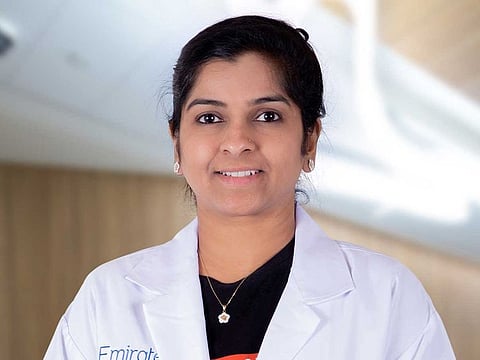Dubai girl with ‘absent ovaries’ is among only two such cases globally
7-year-old Maryam’s rare case has so far been reported in an 18-year-old in Turkey

Dubai: When seven-year-old Maryam, a Syrian expat in Dubai, was rushed to the Emirates Hospital-Jumeirah with acute abdominal pain in October last year, little did the doctors realise they had a rarest-of-rare case on their hands.
Seven months later, and a battery of tests, doctors have diagnosed the girl with ‘isolated absence of ovaries’, a condition which they claim has so far been reported in just one more patient — an 18-year-old girl in Ankara, Turkey — in 2008.
Speaking to Gulf News, Dr Sripradha Sudarsanam, specialist paediatrician overseeing the patient, said: “Cases of ovaries being absent along with other reproductive organs [Meyer Rokitansky Syndrome] are common, but absence of ovaries alone has not been reported except for the Turkey case. There is a reference to a case from St Petersburg in 1896, but with MRIs not being prevalent at the time, it cannot be said for sure that this was an isolated absence of ovaries condition.”
The doctor said in Maryam’s case, an MRI revealed absent ovaries and an abnormally small uterus. “Initially, we suspected one of three conditions — external genitalia where it may seem like a girl but the person has male sex chromosomes; absent ovary syndrome; or a hormonal disorder. But when did karyotyping, the presence of XX chromosomes was confirmed, proving that the child was female. Her hormonal tests also came clear.”
The next step was to determine whether Maryam had Mullerian Agenesis, a condition of absent ovaries and abnormalities of the uterus, fallopian tubes, vagina and reproductive system. It was only after that was ruled out that they were able to confirm her isolated absent ovaries condition.
“This condition has been diagnosed in as few as two patients worldwide,” said the doctor.
She said ovaries are essential to produce hormones which are necessary for reproduction, bone health and overall well-being.
She said she would be treating Maryam in the long-term. “When she reaches the age of 14, we will administer hormones to mimic hormonal changes associated with the menstrual cycle and monitor the size of her uterus. The idea is to enable her to develop female features and boost her confidence. In the absence of her own eggs, she would have to go in for invitro fertilisation or other artificial methods of conception.”
Sign up for the Daily Briefing
Get the latest news and updates straight to your inbox



